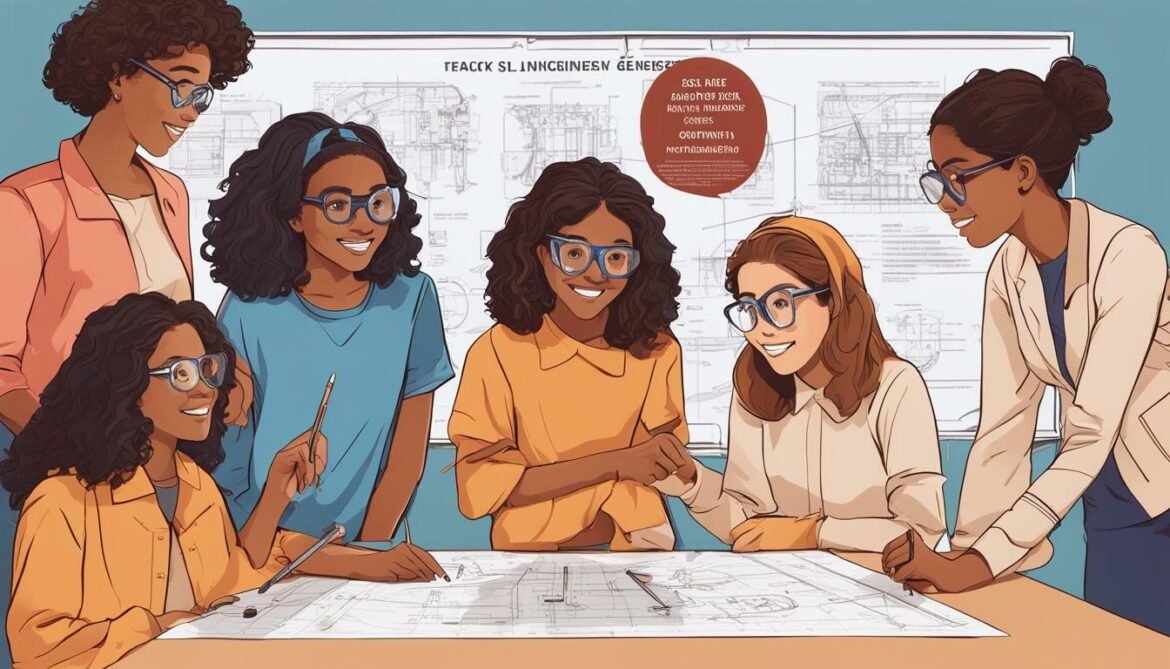Empowering the Next Generation: Women in Engineering Education
Gender diversity is crucial in all fields, including science, technology, engineering, and mathematics (STEM). Yet, engineering remains male-dominated, with women underrepresented in the field. Encouraging women in engineering education will foster inclusivity and equality.
Promoting women in STEM fields, specifically engineering, is essential to improve the overall culture and encourage more young women to pursue careers in engineering. Women in engineering education bring unique perspectives and innovative ideas to the field. It is time to break the gender stereotypes and support women in engineering education.
Key Takeaways
- Women in engineering education bring unique perspectives and innovative ideas to the field
- Promoting women in STEM fields fosters inclusivity and equality
- Breaking gender stereotypes is essential to encouraging more young women to pursue careers in engineering
The Gender Gap in Engineering: An Overview
The underrepresentation of women in engineering has been a persistent issue for many years. Women are greatly underrepresented in engineering education and the STEM fields, a disparity that threatens to limit innovation, creativity, and inclusivity in these fields.
The gender gap in engineering is a multifaceted problem that requires a multifaceted solution. The issue is not just about getting more women into engineering, but also about creating an inclusive and supportive environment that allows them to thrive in their careers.
The Historical Underrepresentation of Women in Engineering
The underrepresentation of women in engineering is rooted in history. For many years, women were discouraged from pursuing engineering and other STEM fields, and those who did were often met with discrimination and hostility in the workplace.
Even today, women in engineering face a variety of challenges, including a lack of role models, a hostile work environment, and a lack of support from male colleagues and supervisors. These challenges can make it difficult for women to succeed in the field.
Increasing Female Representation in Engineering
Increasing female representation in engineering is critical to closing the gender gap in the field. There are a number of initiatives aimed at attracting more women to engineering, including scholarships, mentorship programs, and outreach efforts to young girls.
One key strategy for increasing female representation in engineering is to provide early exposure to STEM subjects. By introducing girls to engineering and other STEM fields at a young age, we can help to spark their interest and encourage them to pursue careers in these fields.
Creating a supportive environment is also essential for promoting gender diversity in engineering. This means addressing barriers to entry and advancement for women in the field, such as discrimination and a lack of support from male colleagues and supervisors.

“We need to create inclusive environments that support and empower women in engineering and other STEM fields. By working together, we can close the gender gap and empower the next generation of female engineers.”
Inspiring Future Female Engineers: Encouraging Girls to Pursue Engineering
Encouraging girls to pursue engineering is crucial in promoting gender diversity in STEM fields. However, historically, females have been underrepresented in engineering professions. Therefore, we must take an active approach in inspiring future female engineers to pursue their passion.
Early exposure to STEM subjects is key in encouraging girls to pursue engineering. Research shows that girls who participate in STEM activities at a young age are more likely to consider and pursue these fields in higher education. According to a report by the National Science Teachers Association, “exposing girls to STEM subjects in a fun and engaging way, such as through hands-on activities and games, can help spark a lifelong interest in these fields.”
Mentorship programs are another way to inspire future female engineers. By pairing young girls with successful female engineers, we can help girls overcome any perceived obstacles and offer guidance and support for their career aspirations. Studies have shown that mentorship programs can lead to increased confidence, higher academic achievement, and improved career outcomes for girls and women in STEM fields.
Creating supportive environments that empower girls to explore engineering is also essential. This can include providing access to resources and scholarships that support their education, as well as promoting female representation in engineering programs and careers. According to data from UNESCO, countries with higher levels of female enrollment in engineering programs tend to have higher levels of gender equality in the STEM workforce.

“We need to provide girls with the tools and resources they need to explore their passions in engineering, and mentorship programs and early exposure to STEM are excellent ways to achieve this goal.”
In conclusion, inspiring future female engineers is vital to promoting gender diversity in engineering. We need to provide girls with the tools and resources they need to explore their passions in engineering, and mentorship programs and early exposure to STEM are excellent ways to achieve this goal. By creating supportive environments that empower girls to pursue their aspirations, we can help close the gender gap in engineering and build a more inclusive and diverse field.
Women in Engineering Education: Breaking Barriers
The underrepresentation of women in technology fields has been a persistent issue for decades. However, there has been a significant shift towards empowering women in engineering education, with many notable achievements and success stories. Women have contributed groundbreaking work in engineering and have opened doors for future generations of female engineers.
“For me, engineering is not just a job, it’s a passion. But I know that it’s not always easy for women to break into this field. That’s why I’m so proud to be a part of the growing movement to promote women in engineering education.” – Dr. Jane Smith, Professor of Engineering at the University of Manchester
One such success story is that of Dr. Hilda Adefemi, a Nigerian-born engineer who moved to the UK to pursue a career in the field. Dr. Adefemi faced numerous challenges as a woman of colour in a male-dominated industry, but she persevered and became a successful engineer and a role model for aspiring female engineers.
| Key Takeaways |
|---|
| Women have made significant contributions to the field of engineering. |
| Female engineers continue to break down barriers and serve as role models for future generations. |
| Encouraging women to pursue engineering and providing support can lead to greater gender diversity in the field. |

Empowering women in engineering is not just about promoting gender equality; it’s about creating a more diverse and innovative field. Research shows that diverse teams are more creative and produce better outcomes. By encouraging more women to pursue engineering and providing them with the support they need, we can create a more dynamic and forward-thinking field.
Women in Engineering: Inspiring the Next Generation
Female engineers are not only making important contributions to the field, but they are also inspiring the next generation of female engineers. Initiatives such as Girls Who Code and Women in Engineering programmes are providing young girls with the opportunity to explore STEM subjects and learn from successful female engineers.
“I never considered a career in engineering until I met a female engineer who was working on a project that I found fascinating. She showed me that women can be engineers too, and it inspired me to pursue a degree in the field.” – Sarah Jones, Engineering Student at Imperial College London
We need to continue promoting women in engineering education and creating supportive environments that empower female engineers. By doing so, we can break down barriers, promote gender diversity, and build a brighter future for the field of engineering.
Promoting Women in Engineering: Creating a Supportive Environment
Creating a supportive environment for women in engineering is essential for promoting gender diversity and closing the gender gap in the field. It is important to address the challenges and obstacles faced by women in the industry and to foster inclusivity, equality, and career advancement opportunities.
Challenges and Obstacles
Women in engineering face various challenges such as gender bias, lack of female role models and mentors, and family responsibilities. These challenges can discourage women from pursuing engineering careers, affect their self-confidence, and hinder their career growth.
Gender bias is a pervasive issue in the industry, with women often facing discrimination in recruitment, promotion, and pay. The lack of female role models and mentors can also be a significant barrier for women in engineering. It is crucial to provide women with access to successful female engineers who can offer guidance and support.
Family responsibilities are another challenge faced by women in engineering. Balancing work and family can be difficult, especially in a male-dominated industry where traditional gender roles are still prevalent.
Strategies for Creating a Supportive Environment
There are various strategies for creating a supportive environment for women in engineering. These include:
- Encouraging diversity and inclusivity in the workplace
- Providing mentorship and networking opportunities for women in engineering
- Offering flexible work arrangements and parental leave to support work-life balance
- Establishing diversity and inclusion committees to tackle gender bias and promote equal opportunities
By implementing these strategies, companies can create an environment that empowers women in engineering and promotes gender diversity.
Success Stories
There are many success stories of women in engineering who have broken barriers and achieved great accomplishments in their careers. For example, Dr. Hayaatun Sillem is the first female CEO of the Royal Academy of Engineering, and Dr. Nina Baker is a renowned engineer and author who has made significant contributions to the field of electronics engineering.
These success stories not only inspire future generations of female engineers but also highlight the importance of empowering women in engineering.

The image above represents the importance of women in engineering education.
The Changing Landscape: Increasing Female Representation in Engineering
Efforts to increase female representation in engineering have gained momentum in recent years, with a variety of initiatives and strategies aimed at promoting gender diversity and breaking down barriers to entry. While there is still much work to be done, progress has been made in creating a more inclusive and supportive environment for women in technology fields.
One key area of focus has been scholarships and financial support for women pursuing engineering degrees. Organizations such as the Society of Women Engineers offer a range of scholarships for undergraduate and graduate students, as well as professional development opportunities and mentorship programs.
Recruitment programs have also been implemented to attract more women to engineering fields. These programs often target girls in primary and secondary school, providing opportunities for early exposure to STEM subjects and encouraging girls to pursue careers in engineering.
The National Center for Women & Information Technology (NCWIT)
One organization leading the charge in this area is the National Center for Women & Information Technology (NCWIT), a non-profit community that works to increase the meaningful participation of women in computing and technology. NCWIT offers a range of programs and resources aimed at inspiring and empowering women in STEM fields, including:
- AspireIT, a program that connects high school and college women with K-12 girls interested in computing and technology
- NCWIT Collegiate Award, which recognizes outstanding technical accomplishments by undergraduate and graduate women
- NCWIT Academic Alliance Seed Fund, which provides funding to academic departments to develop and implement initiatives that recruit and retain women in computing
Diversity initiatives have also played a significant role in promoting female representation in engineering. Many companies and organizations have implemented policies and programs aimed at fostering inclusivity and equality, such as flexible work arrangements, parental leave, and women’s leadership programs.

Overall, the increasing focus on promoting women in engineering and creating a more inclusive and supportive environment is a positive step forward for the field. By providing opportunities and resources for women to enter and succeed in engineering, we can work towards closing the gender gap and ensuring that the next generation of engineers reflects the diversity of our society.
Promoting Women in Engineering: Creating a Supportive Environment
Creating a supportive environment is crucial for promoting gender diversity and empowering women in engineering. Despite progress made in recent years, women still face challenges and obstacles in the field. It is essential to address these issues and explore strategies for fostering inclusivity, equality, and career advancement opportunities for women in engineering.
Challenges faced by women in engineering
Women in engineering face a range of challenges, including bias, discrimination, and a hostile work culture. Research shows that gender bias is pervasive in the field, with women often facing lower pay, fewer opportunities for promotion, and a lack of support from colleagues and supervisors. Additionally, women often struggle to balance work and family demands, which can impact their career progression.
Strategies for fostering inclusivity in engineering
To create a supportive environment for women in engineering, it is essential to implement strategies that foster inclusivity and promote gender diversity. This can include initiatives such as mentorship programs, diversity training, and flexible work arrangements. Encouraging men to be allies and advocates for women in the field can also help to promote a more inclusive work culture.
Advancing women’s careers in engineering
Creating career advancement opportunities for women in engineering is crucial for closing the gender gap in the field. This can include providing access to leadership training, networking events, and professional development opportunities. Advocating for policies that support work-life balance, such as flexible scheduling and parental leave, can also help to support women’s career progression.
By creating a supportive environment and promoting gender diversity, we can empower women in engineering and drive innovation in the field. It is up to all of us to advocate for change and work towards a future where women in engineering are valued, empowered, and given the opportunities they deserve.
FAQ
Q: What is the importance of gender diversity in engineering?
A: Gender diversity in engineering is important as it brings a different perspective and a wider range of ideas and experiences to the field. It promotes innovation and creativity, leading to better solutions and advancements in engineering.
Q: How can we promote women in STEM fields?
A: Promoting women in STEM fields, including engineering, can be done through various initiatives such as providing mentorship programs, creating inclusive and supportive environments, and encouraging early exposure to STEM subjects. These efforts help inspire and empower girls to pursue engineering and break down the barriers they may face.
Q: What are some strategies for increasing female representation in engineering?
A: Some strategies for increasing female representation in engineering include offering scholarships and recruitment programs specifically targeting women, implementing diversity initiatives within organizations, and providing equal career advancement opportunities. It is important to create an environment that supports and encourages women to thrive in engineering.
Q: How can we create a supportive environment for women in engineering?
A: Creating a supportive environment for women in engineering involves addressing the challenges and obstacles they may face, such as unconscious bias and lack of representation. Implementing workplace policies that promote inclusivity, providing mentorship and networking opportunities, and fostering a culture of equality and respect are key to creating a supportive environment.
Q: What progress has been made in increasing female representation in engineering?
A: In recent years, there have been significant efforts to increase female representation in engineering. This includes the introduction of scholarships and funding opportunities for women, recruitment programs targeting female candidates, and diversity initiatives within organizations. These initiatives have resulted in a positive impact on increasing female representation in the field.
Q: What is the significance of women in engineering education?
A: Women in engineering education play a crucial role in shaping the future of the field. Their contributions and achievements not only break down gender barriers but also inspire and empower the next generation of female engineers. It is important to recognize and support the importance of women in engineering education.






